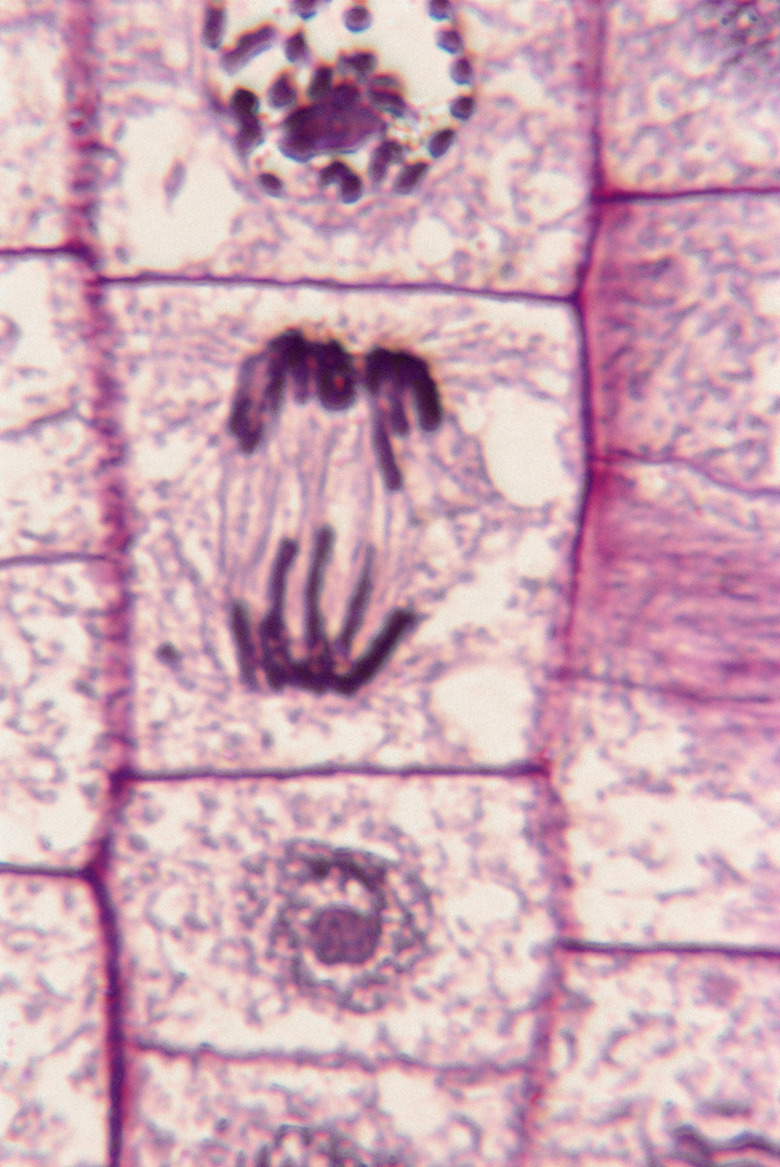Two Purposes Of Mitosis
Mitosis is the process by which eukaryotic cells reproduce asexually, and it closely mimics binary fission in prokaryotes. More simply, it is the splitting in two of one cell to produce two cells that are genetically identical to the parent cell and to each other. That is, no shuffling of DNA (deoxyribonucleic acid, the molecule that serves as the "genetic material" in all living things) occurs in mitosis.
Mitosis is not responsible for transmitting genetic (meaning, heritable) information to the next generation of organisms in the species. The two main purposes of mitosis are contributing to tissue growth and contributing to tissue **repair.**
Cells and the Cell Cycle
Cells and the Cell Cycle
Cells may be **prokaryotic,** or composing the entirety of simple one-celled organisms like bacteria, or eukaryotic, or belonging to the more complex Eukaryota domain (plants, animals, protists and fungi).
Prokaryotes reproduce by simply dividing into two identical daughter cells, a process called **binary fission**. Only eukaryotic cells undergo mitosis.
Cells prepare for mitosis by spending time in a period of the **cell cycle** called interphase, during which cells make a copy of each of its chromosomes, or DNA "chunks." (Humans have 46.) Interphase and mitosis together make up the cell cycle.
Overview of Mitosis
Overview of Mitosis
Mitosis consists of prophase, in which replicated (copied) chromosomes begin to condense in the nucleus of the cell; metaphase, when the chromosome pairs (called chromatids) line up along the line of cell division; anaphase, when sister chromatids are pulled to opposite sides of the soon-to-split nucleus; and telophase, when the nucleus splits.
Mitosis is followed by cytokinesis, in which the whole cell divides, each carrying a new daughter nucleus from mitosis with it.
The Purpose of Mitosis
The Purpose of Mitosis
Mitosis does the same basic thing as binary fission in prokaryotes: It makes two identical daughter cells. Only a few cells in the human body, located in the gonads (ovaries in women, testes in men), use a second, more involved type cell division, called meiosis. **Meiosis** is required for sexual reproduction and transmitting genetic material to offspring.
Mitosis replenishes old and sick cells, and those lost in accidents large and small. You lose countless skin cells per day, and mitosis is what allows you to regrow old, "shed" skin cells. It is also responsible for growth in general, which is especially important in young and embryonic (developing in the womb) organisms.
Examples of Mitosis in the Human Body
Examples of Mitosis in the Human Body
One example of mitosis in the human body that has progressed in an unwanted way is cancer. Cancer is the result of the genes controlling mitosis not working properly, leading to unchecked replication and out-of-control cell and tissue growth.
In the plant world, an example of mitosis at work is a leaf growing larger at the end of its stem or a plant root extending further into the ground. Humans usually see the results rather than the process of growth in the "green" world because growth can occur in plants so slowly.
Mitosis vs. Meiosis
Mitosis vs. Meiosis
Studying side-by side examples of mitosis and meiosis is a good way to make sure you have a handle on both the steps in each and the main differences between these two types of cell division.
While mitosis occurs an unfathomable number of times in your own body in the course of a single day, mitosis never results in the creation of a whole new organism, or even in the creation of a cell destined to participate in reproduction (i.e., a gamete or sex cell).
In the first of the two successive divisions of meiosis, the chromosomes pair up differently in the initial phase, and they exchange genetic material at the chromosomes. This contributes to genetic diversity in the offspring.
Cite This Article
MLA
Beck, Kevin. "Two Purposes Of Mitosis" sciencing.com, https://www.sciencing.com/two-purposes-mitosis-23877/. 10 June 2019.
APA
Beck, Kevin. (2019, June 10). Two Purposes Of Mitosis. sciencing.com. Retrieved from https://www.sciencing.com/two-purposes-mitosis-23877/
Chicago
Beck, Kevin. Two Purposes Of Mitosis last modified August 30, 2022. https://www.sciencing.com/two-purposes-mitosis-23877/
